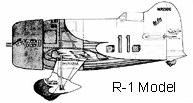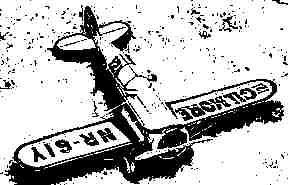 One summer evening I drove to Phil Bardsleyís house in Edmonds for another of his fine dining experiences when the other members of the Air Pirates, Dave Schueler, Paul Hannah, and Phil began talking about developing an air racing game. Dave Sullivan and I listened, not really know much about the subject, but it really caught my interest. By e-mails on following days we talked about airplane availability and scales, and began doing web searches. We searched e-Bay to see what was available, and by the middle of July, we had a plan.
One summer evening I drove to Phil Bardsleyís house in Edmonds for another of his fine dining experiences when the other members of the Air Pirates, Dave Schueler, Paul Hannah, and Phil began talking about developing an air racing game. Dave Sullivan and I listened, not really know much about the subject, but it really caught my interest. By e-mails on following days we talked about airplane availability and scales, and began doing web searches. We searched e-Bay to see what was available, and by the middle of July, we had a plan.
First we needed a set of rules. Dav Schueler, our resident rules combobulator, modified the highly successful, and extremely fun car racing game Formula De for racing in three dimensions. He created two sets of rules coming from two very different directions. First, for both sets of rules, Dave proceeded from the premise that a plane is a plane is a plane. It didnít matter if it was a GeeBee or Laird Super Solution. In rule set A the players, with a fixed number of points, had to purchase important attributes of their planes and apply them in the race. If they chose poorly the game wouldnít go at all well for them. Under plan B the players used their points to purchase pilot quality, fuel, and airframe strength, with the ability to use all of those attributes during the game. We chose plan B, and I think it was a great choice.
 Our second task was to decide on airplanes. We had to choose an era first. The Reno air races of the 60ís was an interesting subject because they raced so many great planes from World War II. P-51Dís, F8F Bearcats, T-6ís and Hawker Sea Furys are just great planes, but they just didnít match up with classics from the 20ís and 30ís. Biplanes, the GeeBee with its enormous barrel fuselage and teeny wings, and the Schneider cup floatplane racers are just a few examples of the interesting designs during this aeronautically important developmental era. In the 50ís Hawk made a series of 1/48th scale racers from that era. Testors owns those Hawk products now and we have snapped up all the variants that are available. Weíve also closely scanned E-bay for some airplane possibilities that Testors no longer produces such as the old Hawk Supermarine racer, Mr. Mulligan, and recently a P-35 racer.
Our second task was to decide on airplanes. We had to choose an era first. The Reno air races of the 60ís was an interesting subject because they raced so many great planes from World War II. P-51Dís, F8F Bearcats, T-6ís and Hawker Sea Furys are just great planes, but they just didnít match up with classics from the 20ís and 30ís. Biplanes, the GeeBee with its enormous barrel fuselage and teeny wings, and the Schneider cup floatplane racers are just a few examples of the interesting designs during this aeronautically important developmental era. In the 50ís Hawk made a series of 1/48th scale racers from that era. Testors owns those Hawk products now and we have snapped up all the variants that are available. Weíve also closely scanned E-bay for some airplane possibilities that Testors no longer produces such as the old Hawk Supermarine racer, Mr. Mulligan, and recently a P-35 racer.
Our next task was to actually build the models. For those of us who havenít actually built a plastic model in 30 years-let alone a biplane, it has been challenging. However, I think we have all had fun. There is something refreshingly different about choosing six airplanes to build rather than 300 figures to paint. It is a non-military, though still historical theme. By building the planes it is really a great investment in the game-you want to win!!
Our group has played the game several times now. We have done some tweaking of the rules, and our first public test was yesterdayís Museum of Flight day. First, let me just say that if you arenít going to the Museum days youíre missing out. It is a fabulous venue, with easy parking, cheap and decent food in the museum, a nice gift shop, and some very nice games. Plus, you get to mosey about the Museum, commune with a FG-1 Corsair. They have a Spitfire MKV!! The games were great, and there was lots of time to socialize. There is that admission fee, and it isnít cheap, but you get more than just the gaming.
We ran two races at the Museum do Flight Game Day (Sept. 29), with six planes in each race - probably the maximum we could safely manage. The gamers caught on quickly, and by the second game were running the race themselves. Three of the gamers were under 15, and all seemed to have fun. This could be one of those ďafter hoursĒ convention games or a stand alone game that could run several times in a gaming period. I know that I have enjoyed it, and have a great deal of investment in the fact that my two Laird racers have only lost one of five races.
Golden Age Air Racing is a great game, and is also a great project. First, itís historical-and much less weird than many historical projects Iíve contemplated. It is non-military, which was unusually refreshing. It calls on model-building skills that I havenít used since high school-and I confess that overall I enjoyed building the planes. The game is hoot-if you canít have fun playing this game, you should be a solitaire gamer.
Back to Citadel Fall 2001 Table of Contents
Back to Citadel List of Issues
Back to MagWeb Master Magazine List
© Copyright 2001 by Northwest Historical Miniature Gaming Society
This article appears in MagWeb (Magazine Web) on the Internet World Wide Web. Other military history articles and gaming articles are available at http://www.magweb.com